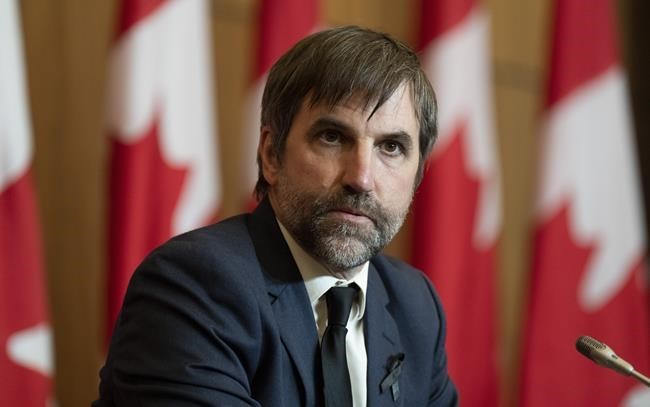OTTAWA — Environment Minister Steven Guilbeault said banks and other financial institutions need to update the way they label carbon-price rebates, after another round of the payments went out to Canadians without making it clear where the money came from.
The deposits sent Friday ranged from $186.25 for a family of four in Ontario to $208 in Manitoba, $269.75 in Alberta and $275.25 in Saskatchewan. The amounts differ because the amount of carbon price paid varies depending on the fuel sources used for heat and electricity.
But depending on where you bank, the deposits also carried vastly different labels.
Some saw payments labelled "climate action incentive Canada," which is the official term the federal government uses to describe the carbon-price rebates — and what it has asked the banks to call the deposit.
Not all of them did.
Some Canadians got a deposit called "Canada CAI," while others see an "EFT deposit from Canada" or an "EFT Credit Canada." In one case, recipients see the deposit confusingly labelled "NOT Climate Action Incentive."
"It is crucially important that Canadians not only receive these rebates, but that they are clearly informed about getting the rebate," said Guilbeault. "That way, households can make the most of their energy decisions and rebates."
The Liberal carbon-pricing policy is predicated on the belief that people will change their fuel habits if the price they pay for greenhouse-gas emitting fuels is rising.
The rebates, which you receive regardless of how much carbon price you pay, were added to help keep the public on board by ensuring most families aren't worse off as a result of the policy.
But the government hasn't been great at communicating that.
Ken Boessenkool, a conservative strategist at Sidicus Consulting who favours carbon pricing as a climate change solution, said if the carbon price fails, the Liberals have only themselves to blame.
"They should have spared no expense explaining to Canadians that they would get full rebates for all taxes paid," he said.Â
"It should be no surprise that they are being attacked for raising taxes, as they have done little to promote the fact that they simply aren’t. They handed Conservatives a large and continuing gift."
Until this year, the rebates were melded into annual tax returns. Canadians who were owed a tax refund would have the "climate action incentive" added to their refund cheque, while Canadians who owed taxes would see the incentive go toward reducing their tax bill.
Winnipeg Liberal MP Terry Duguid, the parliamentary secretary for the environment minister, said the move to quarterly payments is intended to make them more visible. But when the first payment was unclearly labelled in July, his constituency office got calls from people wondering where their rebate was.
The government asked the banks to fix it this time, and is frustrated it didn't happen across the board.
Duguid said the government is going to follow up with the banks again.
"What we're trying to do as a government is bring some consistency to the communications on that," he said in an interview.
A spokeswoman for Scotiabank told The Canadian Press the payment is now called a "climate action incentive" for customers who use the mobile app, and the bank is working to update it for all platforms.
Duguid also said the Conservatives are "misinformation experts" on carbon pricing.
"They only talk about the price on pollution, or what they call the carbon tax," he said. "But they don't talk about the fact that eight out of 10 families at the end of the day are better off, they receive more back on climate incentive payments than they pay at the pump. They never mention that. They never will."
Conservative Leader Pierre Poilievre has pledged to "axe the carbon tax" if he wins the next election, and he and his caucus are hammering the government over its plans to triple the price.
In question period Monday, Poilievre demanded the government "cancel their plan to triple the tax."
"People cannot afford these taxes," he said.
The "tripling" of the carbon price, to $170 per tonne from $50 per tonne, will take effect over the next eight years. It will increase the cost to 37 cents per litre of gasoline in 2030, up from 11 cents now, and to 33 cents per cubic metre of natural gas from 10 cents.
The rebates increase each year to keep pace with the increased price. In 2021-22 a single adult received $490 in Alberta, $500 in Saskatchewan, $360 in Manitoba and $300 in Ontario. In 2022-23, the annual amounts rose to $539 in Alberta, $550 in Saskatchewan, $416 in Manitoba, and $373 in Ontario.Â
Additional amounts are added for a spouse and for every child in the household.
This report by The Canadian Press was first published Oct. 17, 2022.
Mia Rabson, The Canadian Press




